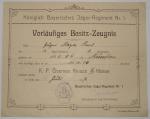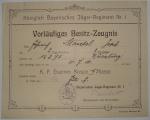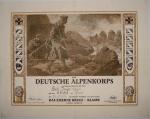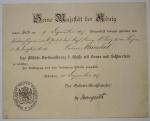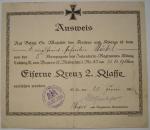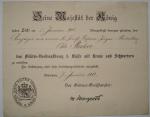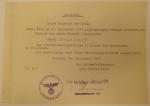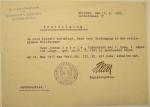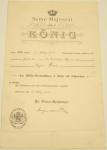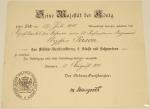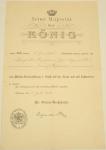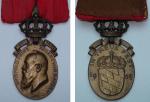-
Posts
57 -
Joined
-
Last visited
Content Type
Profiles
Forums
Blogs
Gallery
Events
Store
Everything posted by Bavaria
-
Deal all, actually the colour changed from red to blue and then back to blue: the early cases for the MVO and MVK had been in a dark red/wine red. See a case for an early MVO (Ritterkreuz 1. or 2. class) from A. Hausinger who produced only until 1876. Later types, also pre-1914, had been blue and changed during WW1 to red. No idea why they changed the colours, at least the motivation to go with blue might be that it´s a national colour for Bavaria "Weiss-Blau". Kind regards Rudi
-
Hello, the former bearer should have been a Bavarian veteran, because the Bavarian MVK or MVO is at first position. In my opition, 3rd and 4th position belongs also to Bavarian medals: 3rd Jubilee medal from 1905 or Luitpold medal (Bronze, awarded 1911 with the Jubilee-medal - this was due to 90th birthday of Prinzregent Luitpold). The 4th position might be for Goldene Hochzeitsjubiläumsmünze 1923 (worn with same ribbon like Jubilee medal). I just miss a Long service award. Officer with no permanent term of service? Best regards Rudi
-

EK 1914 Alpenkorps Iron Cross Documents...
Bavaria replied to Chris Boonzaier's topic in Germany: All Eras: The Iron Cross
It seems to be common, that there was some time between the real award ("fix the EK on the soldier´s breast") and also doing the paper work ("also give him his document"). Here is an other document of 1. JgRgt: Jäger Meyer got his EK on 11th of November 1916 and his document also in July 1917. Until April 1917 the regiment participated in the Romanian-campaign and they were in trench warfare during June and July 1917, but at Oberelsaß (quite calm). So it seems they used the time doing administration work. -

EK 1914 Alpenkorps Iron Cross Documents...
Bavaria replied to Chris Boonzaier's topic in Germany: All Eras: The Iron Cross
Here is a "Vorläufiges Besitzzeugnis" of 1. Jäger-Regiment to a Fähnrich of 2. JgBtl, who was awarded his EK II at the 20th of July 1916, but the document was issued at the 12th July of 1917, almost one year later! OK, it might be a second document due to loosing the first one (but we don´t know). Please pay attention to the signature: Oberstleutnant (later Oberst) Karl Paulus, (Pour le Merite in 1918). -

EK 1914 Alpenkorps Iron Cross Documents...
Bavaria replied to Chris Boonzaier's topic in Germany: All Eras: The Iron Cross
Hello Chis The Leiber-document is amazing! I can´t remember that I´ve ever seen one before. I know the first Alpenkorps-document for Iron Crosses (black-and-white printing), but I haven´t one in my collection (not yet). My earliest document is attached below, but it just witnesses, that this soldier got his EK at the 24.12.1916, but unfortunaltelly not, when he got this certificate. -

EK 1914 Alpenkorps Iron Cross Documents...
Bavaria replied to Chris Boonzaier's topic in Germany: All Eras: The Iron Cross
Hello Chris, I´ve several EK documents and I can itentify this types: 1st type: from "Kunst im Druck", "Italien" and "Nord-Frankreich" is not mentioned at the battle-colums at the left and on the right side, 2nd type: from "Dietz", "Italien" and "Nord-Frankreich" are mentioned at the battle-colums. Usually the soldiers get first a interim/preliminary document for their EK and later a handsome EK-document (e.g. "Vorläufiges Besitzzeugnis") such as the Alpenkoprs-document. Between both dates some time passed by and in the end they used just the documents they had available. So I have 2 documents for soldiers who got their EK at the 28th of October 1917. One document ist a 1st type signed by v. Krafft (also he wasn´t commander anymore!) and the other one ist a 2nd type signed by v. Tutschek. v. Tutschek´s signature can also found on both types. Regards Rudi -

EK 1914 Alpenkorps Iron Cross Documents...
Bavaria replied to Chris Boonzaier's topic in Germany: All Eras: The Iron Cross
Hello Chris, Your first signature is from GenLt Ludwig Ritter von Tutscheck, third and also last commander of the Alpenkorps ( since 5th of September 1917 until the end). The second one is from GenLt Leo Sonntag, a Prussion General who was commander between 1st of March 1917 until 4th of September 1917. The first commander of the Alpenkorps was Gen Konrad Krafft von Dellmensingen until the 28th of February 1917. A picture of his signature is attached below. Regards Rudi -
Hello The Bayerisches Armeemuseum (Bavarian Army Museum) in Ingolstadt has 3 Field Marshal batons of King Ludwig III.: his Bavarian parade baton and both of his interim batons (Bavarian and Prussian). I took some pictures, whenn I was there last time. Due to the glass cas it was not easy to make good pictures. Regards Rudi
-
A further award of an MVK 3a but to a Prussian Oberjäger. Units were not mentioned on the documents in the second half of the war. So we can just guess in which he served (maybe Reserve-Jägerbataillon 10 or 14?). Someone wrote "MGK" (=Maschinen-Gewehr-Kompanie) on it at the upper right corner with a pencil.
-
This MVK 2a is from Leser (2nd or 3rd type). I´m quite sure, that swords had been removed. Didn´t it also have a mark "900" in the cylinder? Since autumn 1914 just the medaillons for the 2nd classes were made from silver (contract with the makers), so the mark was not genuine. Jeffseka: your MVK shown in post 286/288 was made by Deschler, who used marks not on every MVK. Regards Rudi
-
The card mentiones a "Verdienst-Kreuz mit Schwertern II. Klasse". As a Bavarian he might get a Bavarian Militär-Verdienstkreuz. But a 2nd class for a private? Just if it is the 2nd pattern of the Militär-Verdienstkreuz, awarded during 1905-1913. After 1913 he had to be a Vizefeldwebel or Feldwebel (staff seargeant/seargeant first class). Usually during the colonial wars a soldier was first awarded with a Prussian medal and than by his "nation". So I think the Kaiser-Wilhelms-Medaille could be the war merit medal (Militär-Ehrenzeichen). Maybe after his death nobody of his relatives in Bavaria knew the correct name of this medal and just created this name. What do you think? Regards
-
Hello @Sergio: Your MVK shown in post #173-179 is a piece produced after 1918. It has no details form one of the official 5 Bavarian makers (Deschler, Hemmerle, Lauer, Leser and Weiss). It should be from the 1920/30ies, but these types are often found (also on genuine bars). So stil a nice item. @dond: It´s the same with your MVK 2nd class with crown and swords. Also a piece after 1918. The "L" is very specific. Unfortunatelly I can´t tell you the maker, but Godet, Steinhauer & Lück, Sedlaczek used to produced them for veteran´s demand after 1918. Also a beautiful piece! Kind regars Rudi
-
Hello Indeed it´s easy to remove swords from MVKs. But there ist sometimes the possibilitiy to see some prints/scratches at the upper arm of a MVK (where the swords had been formerly fixed). You can see some examples for these scratches at attached picture. I´ve marked them with a red arrow. You can also see a scratch at the MVK at post nr. 10. The MVK at Post nr. 1-4 is a late Weiss (e.g. design of the lion). It´s a good example, that not all MVK with removed swords shows these scratches. But beware: even swords from early Leser can be removed! Kind regards Rudi
-
Also in 1911 officers and NCO, who had no Jubiläumsmedaille, got the Prinzregent Luitpold-Medaille in Bronze. But this medal was not worn with the red ribbon, it was worn with the ribbon of the Jubiläumsmedaille (red with green edges). Here is a document also with the additon "am Bande der Jubiläumsmedaille"



.thumb.jpg.c5cf8f34536f8faa8a2631adf123c785.jpg)

.thumb.jpg.03120a737efd7551fa3697aab61760c5.jpg)
.thumb.jpg.e3c200cad1b5cebe8e2b4756fbf24af5.jpg)
